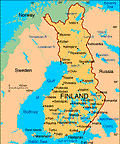Finland
Facts & Figures

-
President: Sauli Niinisto (2012)
Prime Minister: Juha Sipilä (2015)
Land area: 117,942 sq mi (305,470 sq km); total area: 130,558 sq mi (338,145 sq km)
Population (2014 est.): 5,268,799 (growth rate: 0.56%); birth rate: 10.35/1000; infant mortality rate: 3.36/1000; life expectancy: 79.69
Capital and largest city (2014 est.): Helsinki, 1.17 million
Other large cities: Espoo, 229,500; Tampere, 201,200; Vantaa, 189,200; Turku, 178,100
Monetary unit: Euro (formerly markka)
National name: Suomen Tasavalta—Republiken Finland
Languages: Finnish (official) 89.3%, Swedish (official) 5.3%, other (includes small Sami- and Russian-speaking minorities) 5.4% (2013 est.)
Ethnicity/race: Finn 93.4%, Swede 5.6%, Russian 0.5%, Estonian 0.3%, Roma (Gypsy) 0.1%, Sami 0.1% (2006)
Religions: Lutheran 78.4%, Orthodox 1.1%, other Christian 1.1%, other 0.2%, none 19.2% (2010 est.)
National Holiday: Independence Day, December 6
Literacy rate: 100% (2012 est.)
Economic summary: GDP/PPP (2014 est.): $221.5 billion; per capita $40,500. Real growth rate: –.2%. Inflation: 1.3%. Unemployment: 8.6%. Arable land: 7.4%. Agriculture: barley, wheat, sugar beets, potatoes; dairy cattle; fish. Labor force: 2.665 million; agriculture and forestry 4.4%, industry 15.5%, construction 7.1%, commerce 21.3%, finance, insurance, and business services 13.3%, transport and communications 9.9%, public services 28.5%. Industries: metals and metal products, electronics, machinery and scientific instruments, shipbuilding, pulp and paper, foodstuffs, chemicals, textiles, clothing. Natural resources: timber, iron ore, copper, lead, zinc, chromite, nickel, gold, silver, limestone. Exports: $78 billion (2014 est.): machinery and equipment, chemicals, metals; timber, paper, pulp (1999). Imports: $72.01 billion (2014 est.): foodstuffs, petroleum and petroleum products, chemicals, transport equipment, iron and steel, machinery, textile yarn and fabrics, grains. Major trading partners: Sweden, Germany, Russia, UK, U.S., Netherlands, Denmark, China (2013).
Communications: Telephones: main lines in use: 890,000 (2012); mobile cellular: 9.32 million (2012). Broadcast media: a mix of publicly operated TV stations and privately owned TV stations; the 2 publicly owned TV stations recently expanded services and the largest private TV station has introduced several special-interest pay-TV channels; cable and satellite multi-channel subscription services are available; all TV signals have been broadcast digitally since September 2007; analog broadcasts via cable networks were terminated in February 2008; public broadcasting maintains a network of 13 national and 25 regional radio stations; a large number of private radio broadcasters (2008). Internet hosts: 4.763 million (2012). Internet users: 4.393 million (2009).
Transportation: Railways: total: 5,944 km (2013). Highways: total: 78,000 km; paved: 50,000 km (including 700 km of expressways); unpaved: 28,000 km (2012). Waterways: 8,000 km note: includes Saimaa Canal system of 3,577 km; southern part leased from Russia (2013). Major seaports: Helsinki, Kotka, Naantali, Porvoo, Raahe, Rauma. Airports: 148 (2013).
International disputes: various groups in Finland advocate restoration of Karelia and other areas ceded to the Soviet Union, but the Finnish Government asserts no territorial demands.

